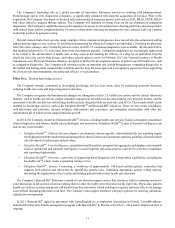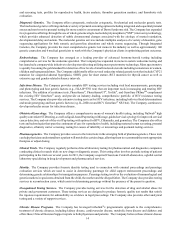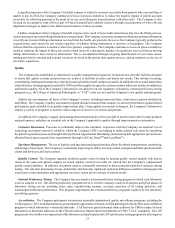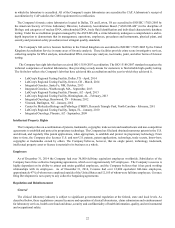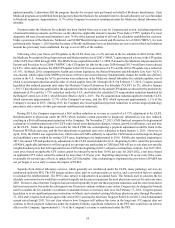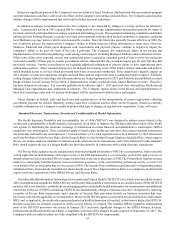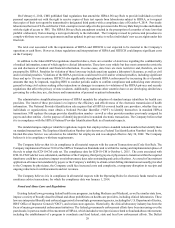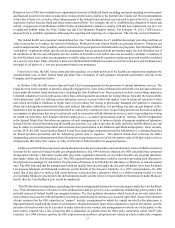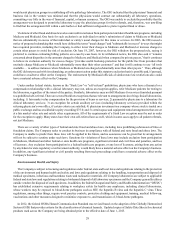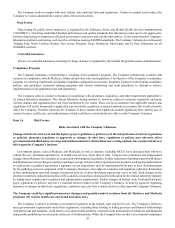LabCorp 2014 Annual Report Download - page 23
Download and view the complete annual report
Please find page 23 of the 2014 LabCorp annual report below. You can navigate through the pages in the report by either clicking on the pages listed below, or by using the keyword search tool below to find specific information within the annual report.21
A significant portion of the Company’s bad debt expense is related to accounts receivable from patients who are unwilling or
unable to pay. In 2014, the Company continued its focus on process initiatives to reduce the negative impact of patient accounts
receivable by collecting payment at the point of service and refining its internal patient collection cycle. The Company is also
focused on an enterprise-wide effort as part of Project LaunchPad to identify clients with high concentrations of write offs and
implement strategies to improve the financial performance of those accounts.
Another component of the Company’s bad debt expense is the result of non-credit related issues that slow the billing process,
such as missing or incorrect billing information on requisitions. The Company vigorously attempts to obtain any missing information
or rectify any incorrect billing information received from the health care provider. However, the Company typically performs the
requested tests and returns the test results regardless of whether billing information is incorrect or incomplete. The Company
believes that this experience is similar to that of its primary competitors. The Company continues to focus on process initiatives
aimed at reducing the impact of these non-credit related issues by reducing the number of requisitions received that are missing
billing information or have incorrect information. This is accomplished through on-going identification of root-cause issues,
training provided to internal and external resources involved in the patient data capture process, and an emphasis on the use of
electronic requisitions.
Quality
The Company has established a comprehensive quality management program for its laboratories and other facilities designed
to assure that quality systems and processes are in place to facilitate accurate and timely test results. This includes licensing,
credentialing, training and competency of professional and technical staff, and process audits. In addition to the external inspections
and proficiency testing programs required by CMS and other regulatory agencies, systems and procedures are in place to emphasize
and monitor quality. All of the Company’s laboratories are subject to on-site regulatory evaluations, external proficiency testing
programs (e.g., the College of American Pathologists, or “CAP”), state surveys and the Company's own quality audit programs.
Quality also encompasses all facets of the Company’s service, including turnaround time, client service, patient satisfaction,
and billing. The Company’s quality assessment program includes measures that compare its current performance against desired
performance goals detailed in its quality improvement plan. Using quality assessment techniques, the Company’s laboratories
employ a variety of programs to monitor critical aspects of service to its clients and patients.
In addition, the Company’s supply chain management department provides oversight to monitor and control vendor products
and performance, and plays an essential role in the Company’s approach to quality through improvements in automation.
Customer Interaction. Processes to continually improve the customers’ experience with the Company are essential. Use of
technology and improvements in workflow within the Company’s PSCs are helping to reduce patient wait times by expediting
the patient registration process (through LabCorp Patient Appointment Scheduling) and ensuring that appropriate specimens are
obtained based upon requested test requirements (through LabCorp TouchSM and AccuDraw®).
Specimen Management. The use of logistics and specimen tracking technology allows the timely transportation, monitoring,
and storage of specimens. The Company is continually improving its ability to timely collect, transport and track specimens from
clients and between LabCorp locations.
Quality Control. The Company regularly performs quality control testing by running quality control samples with known
values at the same time patient samples are tested. Quality control test results are entered into the Company's computerized
quality control database. In addition, the patient mean is continually monitored to detect potential analytical variances during
testing. The real-time monitoring for any statistically and clinically significant analytical differences enables technologists and
technicians to take immediate and appropriate corrective action prior to release of patient results.
Internal Proficiency Testing. The Company has an extensive internal proficiency testing program in which each laboratory
receives samples to test. This internal proficiency program serves to test the Company’s analytical and post-analytical phases of
laboratory testing service including order entry, requisitioning systems, accuracy, precision of its testing protocols, and
technologist/technician performance. This program supplements the external proficiency programs required by the laboratory
accrediting agencies.
Accreditation. The Company participates in numerous externally-administered quality surveillance programs, including the
CAP program. CAP is an independent non-governmental organization of board-certified pathologists which offers an accreditation
program to which laboratories voluntarily subscribe. CAP has been granted deemed status authority by CMS to inspect clinical
laboratories to determine adherence to the Clinical Laboratory Improvement Amendments of 1988 (“CLIA”) standards. The CAP
program involves both on-site inspections of the laboratory and participation in CAP's proficiency testing program for all categories


